
Picking up Rodan's Fifteen Quiet Years, a highly anticipated collection from the short-lived Louisville greats, was the highlight of my biannual decimation of Chicago record stores. One key caveat: I had already heard every song on the vinyl. I own a few copies of the How the Winter Was Passed single, grabbed The Machines from Record Service in Champaign to hear
"Darjeeling" (with the clerk, Todd Bell from Braid, praising my purchase on the merits of that song), mail-ordered Half-Cocked on VHS along with its soundtrack to hear “Tron,” scoured enough used bins to find the Compulsiv for Two single with the Aviary version of "Shiner," traded bootleg cassettes to hear the rest of Aviary and the live version of "Big Things, Small Things" from the initial pressing of Working Holiday, and hunted down their Peel Session on the earliest peer-to-peer filesharing networks. My years of Rodan obsession removed most of the surprises from Fifteen Quiet Years, but not the excitement of its long-overdue corporeal existence.
To reiterate the key point: Rodan remain worthy of obsession. With no slight to their Louisville forefathers Slint, Rodan's family tree reigned over my high-school notebooks. The group had split up before I first heard 1994's Rusty, their lone full-length, but my ravenous appetite for their blend of post-rock, math-rock, hardcore, post-hardcore, and indie rock only grew from the mystery of their short lifespan. No matter how many related acts I tracked down—boat-crazed math-rockers June of 44, neo-classical troupe Rachel's, bastions of beautiful restraint The Sonora Pine, slightly less boat-crazed math-rockers The Shipping News—I could never find one that precisely replicated what made Rodan so intoxicating, which is why I spent so much time sifting through used bins for the ephemera collected on Fifteen Quiet Years. Rodan possessed characteristics of all of their offspring, but what those later groups lacked (or perhaps could never have had) was the fiery passion of youth. The blistering hardcore of "Shiner" and the planet-shifting emotional gravity of "Everyday World of Bodies" mattered absolutely to its authors. That intensity is hard to maintain and harder to repeat in different situations. You could say that's the raison d'être of emo as a genre, which Rodan presumably represents along with the others I mentioned above, but very few of its acts overwhelm like Rusty does. (Rites of Spring and pre-reunion Sunny Day Real Estate are the only ones that come to mind.) Couple that boundless passion with the compositional maturity of "Bible Silver Corner" and you have a good sense of why I became a zealot.
Even though I wasn't actually around for its demise, I enjoyed theorizing on why Rodan split. I drew factions through their family tree with singer/guitarists Jason Noble and Jeff Mueller on one side (given their eventual recoupling in The Shipping News) and singer/bassist Tara Jane O'Neil and final drummer Kevin Coultras on the other (since they stuck together in The Sonora Pine). That divide overlooked how both Mueller and Coultras guested on Handwriting, the 1995 debut LP for Rachel's. I saw how Noble and Mueller continued to write and perform aggressive rock music in The Shipping News (with their final LP, 2010's One Less Heartless to Fear, offering their most palpable dose of fury), while Tara Jane O'Neil gradually shed the seething menace of "Tooth Fairy Retribution Manifesto" in The Sonora Pine, Retsin, and her prolific solo career. Perhaps it was as simple as no longer being 23, no longer feeling "Everyday World of Bodies" in their bones.
The most infuriating aspect of Rodan's demise is how seemingly close they were to having a follow-up to Rusty. With no offense intended to the blistering beauty of "Darjeeling," the instrumental implosion of "Exoskeleton," or the hardcore leanings of "Milk and Melancholy" and "Tron," Fifteen Quiet Years' pre-Rusty output doesn't intrigue as much as its post-Rusty forecasting. If you take "Big Things, Small Things," "Before the Train," "Sangre," "Wurl," "Martin," and The Sonora Pine's "Rungs" (a Rodan leftover not included here), you have six songs spanning roughly forty minutes, the default profile for mid-’90s post-rock.
The core of Hypothetical Rodan Album Number Two would have been “Sangre,” a Tara Jane O’Neil tour de force. Few vocalists deliver haunting evocations with visceral force like O’Neil did in Rodan, and “Sangre” surpasses “Toothfairy Retribution Manifesto” in how smoothly O’Neil shifts gears. “Big Things, Small Things” lines up as the likely single, a Jeff Mueller-sung rocker with more anthemic melodies than anything on Rusty. It’s halfway between Rusty and June of 44’s “Rivers and Plains” (their superlative contribution to the Lounge Ax Defense and Relocation compilation). From there, HRA #2 goes heavy on math-rock, with the eleven-minute “Before the Train” flexing its muscles in stops and starts, “Wurl” careening between a tricky riff and a dreamy, cathartic midsection reminiscent of June of 44’s Engine Takes to Water, and “Martin” throwing low-end haymakers. On The Sonora Pine’s debut LP, “Rungs” floats along percussion-free on Samara Lubelski’s violin, so it could have acted been a palette-cleanser for all of these math-rock workouts, or that version could have dropped weight from its original incarnation.
The sum of these parts is difficult to calculate. It’s hard to imagine the rigid “Before the Train” evolving much before another recording session with Bob Weston, but the two live versions of “Wurl” in the downloadable extras of Fifteen Quiet Years are noticeably different. Mueller and O’Neil would be well-represented vocally, but the fire of Noble’s “Shiner” and “Everyday World of Bodies” is missing. Would Noble write another blast of near-hardcore like “Shiner” or “Milk and Melancholy” to fill that void? No matter how close Rodan came to having the material necessary for a second album, it remains more mystery than reality, and Fifteen Quiet Years is the closest we’ll ever get to solving it.
In some ways, it’s bittersweet that Fifteen Quiet Years officially closes the door on Rodan. Even in an era where nearly every burnt bridge can seemingly be rebuilt, I never expected a proper Rodan reunion, but this is it. Jason Noble’s tragic passing in 2012 cut the roots of Rodan’s family tree. No more Shipping News, no more Rachel’s, no more Per Mission, no more Young Scamels. As thrilled as I am at the existence of Fifteen Quiet Years, since it provides the chance for more fans to hear “Sangre” and “Before the Train,” stunning album artwork from Jeff Mueller’s Dexterity Press, and one final gem for excavation in “Wurl,” it comes with an uncomfortable sense of finality. By no means should this point dissuade you from picking up Fifteen Quiet Years (or hearing Rusty for the first time, if by some accident you’ve made it this far without doing so), but know that a hard stop awaits.
|

The fact that I've managed to review many of Exploding in Sound Records' releases to date without turning a review into a label profile demonstrates considerable restraint. It's an easy but now-overdue narrative; it's been a while since a label catered to my tastes so consistently, with many of its acts both drawing from and capably updating the '90s indie/alternative rock that I grew up on. Despite being geographically scattered (with label chief Dan Goldin based in New York City but a cluster of bands in Boston), its roster has the stylistic bleed that was a '90s scene trademark. (Quick case study: many of Champaign-Urbana's class of 1993—Hum, Love Cup, Poster Children, Honcho Overload—shared a fondness for heavy guitars, if not members and/or pedal chains. Contrast that commendable smear with the niche-oriented scene I encountered there at the turn of the millenium.) I've rarely caught only one of their acts on a bill, since Pile, Fat History Month, Grass Is Green, Speedy Ortiz, and Ovlov seem magnetically attracted to each other. And why not? They've all released excellent records that claw at each other for the highest placement on my year-end lists.
This narrative became unavoidable with Ovlov's Am; it's a family affair beyond the obvious distinction of the group's shared parentage. Speedy Ortiz's Sadie Dupuis contributes vocals to four tracks, three members of Grass Is Green add instrumentation, and Grass Is Green's Michael John Thomas III handles production duties. Yet Am is a different beast than Speedy Ortiz's Sports or Grass Is Green's Ronson, offering sludgy-yet-sweet blasts of amp-quaking grunge.
I often avoid using that genre tag, ever wary of what it wrought later in the decade. But Am's reference points steer clear of the radio-friendly unit-shifters that shall not be named (if you say Candlebox's name three times, they appear to a never-ending acoustic set in your living room), sticking with late '80s Dinosaur Jr., Mudhoney, and Nirvana. Steve Hartlett sounds like a dead-ringer for J. Mascis at times, making me wonder if he'll also look like a metal-shop instructor/wizard in twenty-five years. Not that I'm complaining; as much as I've enjoyed the Dinosaur Jr. reunion, Ovlov's "The Well" might very well do a superior job of channeling the energy of You're Living All Over Me. If there's a fight for the affectionate nickname of "Dinosaur Jr. Jr.," I'll side with Ovlov mucking it up with Living All Over Me/Bug sonics than Yuck's Green Mind/Where You Been evocations.
Am's feast of sludge doesn't supersede the songwriting or the melodies essential to repeated plays. Opener "Grapes" could succeed on its basement-show My Bloody Valentine riff alone, but its Hartlett/Dupuis duet is the highlight, offering sweetness and light where those elements . Dupuis's appearances on "The Well" and the aching, mid-tempo "Where's My Dini?" make an argument for her full-time employment in Ovlov, if not for, you know, Speedy Ortiz. The throttling "Nü Pünk" is a showcase for drummer Theo Hartlett, but his brother's melancholic vocal line cuts through the fury. While Steve Hartlett wisely avoids challenging Mascis to a soloing duel, stretching out with noise-wrangling outros on "Blue Baby" and "The Great Alligator" at the record's close proves cathartic. The only head-scratcher is "There's My Dini," which switches from half-spoken, half-ranting verses reminiscent of King Missle to a more familiar, melodic chorus. Nothing against the authors of "Jesus Was Way Cool," but for Ovlov, it's a mood shift away from their sweet spot.
It'll be a challenge to rank Ovlov's Am against Fat History Month's Bad History Month, Two Inch Astronaut's Bad Brother, and Speedy Ortiz's upcoming Major Arcana when December rolls around, but one I'm all too happy to face. Pausing the gravitational pull towards discussing their respective '90s touchstones for a merciful minute, my rankings will ultimately come less from which scuffed CDs they cite and more from their respective songwriting styles. Ovlov's forceful, tuneful melancholy stakes equal claim to both my car stereo and my headphones, so their peers, past and present, on Exploding in Sound Records need to watch out.
|

It doesn’t surprise me that the members of Speedy Ortiz have tired of the ’90s-rock tag. Virtually every review of one of the group’s releases bundles together a few ’90s indie/alt-rock reference points: “Mary Timony fronting Archers of Loaf” (Pitchfork); “Belly, Throwing Muses and the Breeders, but also… Pixies, Chavez and Polvo” (); “Kudgel or Swirlies, or… Thingy” (Boston Globe); “influenced almost exclusively by the Matador Records roster circa ’95” (Stereogum); “early Sebadoh/Sentridoh, Helium’s pre-Pirate Prude singles, or a guitar-overdosed version of Liz Phair’s Girly Sounds demos” (this very site). It’s death by flattery—none of the references are used negatively, but the cumulative effect transports Speedy Ortiz from active status in 2013 to the back pages of a musty 1996 copy of Magnet. If not for the tremendous array of names dropped, these reviews would push Speedy Ortiz into the singular, purified nostalgia of a tribute act. Come see Chavest, Northampton’s most debonair Chavez cover band.
Here’s the rub: however exhausting the constant decade devolution must be for Speedy Ortiz, there may not be a better time to satiate the ’90stalgia urge. Consider how many ’90s staples have embarked on reunion tours and/or had their work reissued with glowing new liner notes in the past few years, or instead, try to think of a few who haven’t. These bands have returned to larger, more receptive audiences. Older listeners have either forgotten or forgiven any late-period slides. Newer fans are ecstatic about the once-implausible opportunity to see one of their favorites in concert. Yet comparatively few of these acts have released any new music, and those who have are typically feeding into the legend, not creating a new one. Superchunk’s Majesty Shredding, for example, was a perfect encapsulation of what fans hoped to hear from a new Superchunk record (i.e., their signature balance of melody and energy), but it doesn’t challenge any long-standing notions about their sound, except, perhaps, the idea that their period in the sun had ended before Come Pick Me Up and Here’s to Shutting Up. Both fans and critics are more receptive now to that era of bands
(and bands influenced by that era) than any time since 1999. It’s not like there weren’t Pavement-influenced acts in the mid-’00s—the ever-infuriating name Tapes ’n Tapes assures me of that—but I don’t recall them being viewed with the same rose-colored glasses.
With full sympathy for Speedy Ortiz’s exhaustion over the ’90s tag, its constant application is largely to their benefit. And as I wrote in my review of their first three releases, Speedy Ortiz does a much better job recontextualizing this era than their peers. Part of the fun of Speedy Ortiz’s music is connecting the dots. Last year’s Sports EP practically authors a companion mix tape—there’s the Breeders’ combination of hooks and lust on “Basketball,” the pairing of pre-bed-shitting Veruca Salt allure and Polvo weirdness of the lurching “Indoor Soccer,” the surprising tenderness of Pavement’s “Here” successfully updated in “Curling,” a wordplay-driven Brighten the Corners-era anthem in “Silver Spring,” and an Unwound guitar freak-out to close out “Suck Buddies.” I’d enjoy Sports if these reminders were all it had to offer, but what makes it a worthy successor to the ’90s tradition of essential EPs is how the songwriting trumps the song-referencing. “Curling” isn’t an empty pointer to “Here,” it’s a surprisingly early embrace of adult life when remembering an impulsive relationship with an ex. Sadie Dupuis comes across as a compelling, charismatic lyricist, not the Wikipedia list of ’90s indie rock bands. Yes, Sports recalls that era, but it also transcends it.
What Speedy Ortiz offers over those stasis-cherishing reunions is unfettered, rapid evolution, a process that’s twenty years in the rearview for Pavement and Superchunk. There was a huge leap from the one-woman bedroom recordings of The Death of Speedy Ortiz / Cop Kicker EP to the polished alt-rock of “Taylor Swift” b/w “Swim Fan,” and the Sports EP demonstrates a comparable jump, with the four-piece edition offering newfound precision. They didn’t stop to catch their breath: in concerts following the EP’s release, the rhythm section downright pummeled “Indoor Soccer” and guitarist Matt Robidoux ended sets with noise-crazed antics.
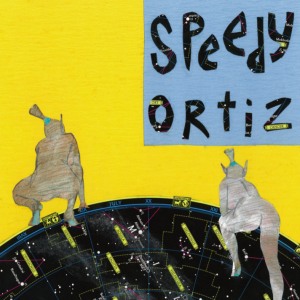
Speedy Ortiz’s newest single, “Ka-Prow!” b/w “Hexxy,” flexes this burgeoning musculature. As a precursor to their upcoming LP, Major Arcana (due 7/9 on Carpark Records, home to Cloud Nothings, Toro Y Moi, and Memory Tapes), this single bolsters two tracks from Speedy Ortiz’s solo-project beginnings with the full power of their current line-up. Gone is the rickety charm of the early versions; these definitive renditions blister the skin with huge, explosive riffs. “Ka-Prow!” even got a Buzz Bin-worthy video. Hopefully they’ll do me a solid and re-record Death of… highlight “Cutco” with similar aplomb.
Whether Speedy Ortiz becomes the Pavement of the ’90s, round two, is well beyond my soothsaying capabilities, but I can predict that your window to see them in the basement circuit and grab their early stuff on vinyl is closing fast. Being present for the ascent is much more exciting than overpaying for the reunion, and I’m much happier about catching Speedy Ortiz in an Allston basement than seeing Pavement trot out the hits in the cavernous Boston University hockey arena.
|

Each Marnie Stern record has been shorter than its predecessor. 2007’s In Advance of the Broken Arm clocked in at 44:33, 2008’s This Is It… chopped its total down to 41:07, 2010’s masterful Marnie Stern lasted 33:58, and 2013’s The Chronicles of Marnia is a scant 32:46. Unless Andy Mueller of OhioGirl designed the album artwork, total running time isn’t something I pay attention to, but in this case it helped support a related observation: each successive Marnie Stern record has felt exponentially shorter.
I’d love to further substantiate that claim with a “notes per minute” statistic, since Stern’s maximalist approach has been similarly toned down over time, but unfortunately, rock criticism hasn’t embraced advanced statistics like baseball or hockey. It would soften the blow of a somewhat backhanded compliment—it’s gotten considerably easier to listen to Marnie Stern’s music. I could appreciate her debut, since the combination of Van Halen-on-speed finger-tapping, enthusiastic cheerleader vocals, and Zach Hill’s frenetic drumming was (and still is) unique. But aside from the comparatively straightforward “Every Single Line Means Something” and a few other tracks, its excesses were exhausting. I stayed with In Advance of the Broken Arm for two reasons: first, it was hard to deny the charismatic charge of her aesthetic; second, the occasional switch to chunky chords was the perfect elixir to the tapping barrage. This Is It… was a step in the right direction, offering tighter arrangements (“The Crippled Jazzer”) and better vocal hooks (“Ruler”), but I still only wanted an EP-length sampling of its tracks. That changed with Marnie Stern, a front-to-back success driven by deeply personal, emotional songwriting (“Transparency Is the New Mystery”) and even more chord-based riffs (“Gimme”). Hell, “The Things You Notice” is even a love ballad!
This history lesson leads me to another potential backhanded compliment about The Chronicles of Marnia: for the first time, a Marnie Stern album has left me wanting more. With new drummer Kid Millions slowing tempos and taking less of a splatter-painting approach to percussion, Stern peeling back layers of guitar, and new producer Nicholas Vernhes putting greater emphasis on Stern’s vocals, it speeds by, feeling every bit as short as its 32:46 runtime. There’s nothing exhausting about Marnia. It’s a pop album, or as close to a pop album as Stern will likely release. Its strangest elements are Stern’s background vocals, like the siren calls of “You Don’t Turn Down” or the “oh-ee-ee-oh” hook of “Year of the Glad,” and those are weirdly infectious. Every time I reach its end, I expect two or three more songs to suddenly appear. It’s disappointing when they don’t.
From an outside perspective, this shift toward the pop terrain of sparser arrangements and bigger hooks could be read as betraying Stern’s maximalist core. I see an alternate route to Marnia’s pop focus—with each release, her personality has come into clearer view, and the gradual receding of the finger-tapped storm has allowed this change to occur. It was simultaneously her sonic signature and a defense mechanism, covering for her self-doubt. “The Things You Notice” was a literal revelation; without Hill’s presence, Stern’s surprisingly hopeful sentiment takes center stage. (I should have seen it coming with her irony-free cover of “Don’t Stop Believin’.”) There’s something profoundly endearing about Stern’s autobiographical tendencies—she’s desperate to succeed on her terms. Like a well-made sports drama, I find myself cheering for the protagonist. (Still won’t wear a “Win Marnie Win” shirt, though.) No wonder why she made a Rocky-themed video.
This doubt-conquering trend is amplified on the self-motivational Marnia. It either recognizes her second-act hurdles or searches for the intestinal fortitude to overcome them. She pairs the album’s most fist-pumping riff with “I am losing hope in my body” on “You Don’t Turn Down,” pleads “Don’t you want to be somebody?” on “Noonan,” rolls the title of “Nothing Is Easy” over and over, declares that “Bittersweet you’ve got to go” on the title track, and affirms “Down and deep I’ll never stop / Won’t give this thing, won’t give it up” in the triumphant closer “Hell Yes.” The most pivotal track is the dramatic, piano-laced “Proof of Life,” which looks to the heavens for a sign, but knows its shift from “I am nothing / I am no one” to “I am something / I am someone” can only come from within. Who knows if she would have come to that conclusion without abandoning the safety net of maximalist finger-tapping.
Returning to potentially backhanded compliment number two, the fact that The Chronicles of Marnia leaves me wanting more is both confirmation of her artistic evolution and the new LP’s lone demerit. I won’t deny that it pales slightly to Marnie Stern, which left me fully satiated with only a minute and twelve seconds of additional runtime (and approximately 58% more notes). But offering a lighter, more inviting companion to that album isn’t a bad thing. Wanting more isn’t a bad thing, especially when three albums ago, I routinely opted for less. I stuck with In Advance of the Broken Arm and This Is It… on the chance that Stern would take this exact course. Now that she has, it’s a relief to simply enjoy the songs without speculating where her sound might be two albums from now. Don’t know, don’t care—I’m in regardless. Maybe she’ll return to her maximalist roots with renewed focus, maybe she’ll strip down the last vestiges of that sound. All I know is that some variation of a self-titled album—Marnie Stern’s Private Parts, perhaps—will remain incredibly appropriate, since her personality will undoubtedly shine through whichever artistic direction she chooses.
|
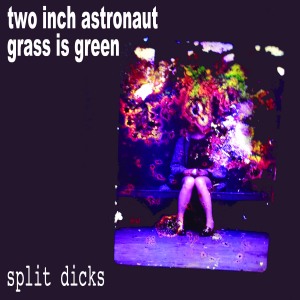
When it comes to seven-inch singles, I’m either complaining about their steadily escalating prices or wishing more bands would release them. Let me be more specific: release them properly. Charging eight bucks for two songs—one from the album people already own, one that’s more likely an alternate take, demo, or tossed-off cover than a must-hear rarity—is testing my faith in the format. If the price can’t come down, increase the value. Reward the faithful with a non-album single like Wire, The Smiths, or Stereolab did. Put something fun down on wax, like Wye Oak’s covers of “Strangers” and “Mother.” Or share space with another excellent band and see who comes out on top.
This single falls into the last category, with Boston’s Grass Is Green and Silver Spring, Maryland’s Two Inch Astronaut each making their vinyl debuts. With each band offering two exclusive songs, Split Dicks can be politely excused from the above discussion of value. The only thing that would have stopped me from recommending this single is if they’d chosen the cover from a Google Image Search of “split dicks,” and fortunately you only get the mental picture (which still makes my crotch recoil).
I’m well acquainted with Grass Is Green—I would have slotted Ronson in my top five LPs of 2012 if I actually got around to, you know, doing one. In classic seven-inch logic, these songs are solid enough to have made Ronson, but wouldn’t necessarily have fit into its flow. “Tasty Hot Air Balloon” struts like an aggro Polvo before breaking into an all-too-short anthemic finale. “You’re Yawning All Over My Baby” flies out of the gate with the spastic energy of their live sets, then runs some math-rock trials. I’d be happy to encounter either song on one of the group’s set lists.
Two Inch Astronaut appear to have been raised on the same steady diet of Dischord/DeSoto post-punk as Grass Is Green, but chose a less frenetic, more melodic direction. These songs are so up my Jawbox/Faraquet/Candy Machine alley that I’m kicking myself for not making it out to a house show in January to see both bands. Hopefully I’ll get another chance this spring after their upcoming album, Bad Brother, comes out.
I know the idea behind split singles is to introduce bands to their respective audiences, but I’d be glad if Split Dicks became a yearly series. Maybe next time Grass Is Green goes mid-tempo and Two Inch Astronaut gets spastic, maybe they cover each other’s songs, maybe they cover DC classics. Just keep away from GIS results for the covers.
|
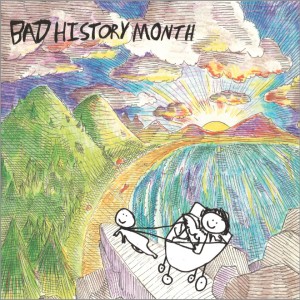
Here’s what I think of, in rough order, when the topic of two-person rock bands comes up: 1. Bands who took the “We only have two members” restriction as a dare to make the most noise possible (godheadSilo, Lightning Bolt, Hella, Big Business). 2. Married or once-married couples banking that romantic chemistry translates to musical chemistry (The White Stripes, Mates of State, The Like Young, and, even though it feels strange to mention them here, The Evens). 3. Holy shit The Black Keys are popular. 4. Watching post-grunge survivalists Local H from the back of The Highdive in Champaign with the evening’s now-implausible opening act The Dismemberment Plan. 5. When you name a band Drums and Tuba, you can’t add a guitarist. Come on. 6. Don’t make me talk about The Dresden Dolls, please don’t. 7. Wait, did I really forget Wye Oak until now?
Somehow I’m not surprised that one of my favorite current acts slipped from memory in favor of archetypes, improbable arena acts, and gimmicks. When I think of Wye Oak, I focus on the songs first, then sometime later the image of drummer Andy Stock playing keyboard bass lines with his left hand will pop into my head, reminding me that they lack a proper bassist. I don’t think of them as a two-piece because there are more important things to think about. Make no mistake, it’s a compliment.
A few months from now, after Fat History Month’s sophomore LP Bad History Month has enjoyed an extended residency on my turntable, I’ll be paying the Boston-based duo the same compliment. Right now I’m busy marveling at the ways guitarist Jeff Meff fills the mix, balancing folk finger-picking, knotted chords, agitated strafing, and panoramic melodies. You might not even realize there’s only one guitarist at work; the first time I saw them, I abandoned an obstructed-view perch for confirmation. Once you do, however, you’ll quickly forget it in the best way possible.
Bad History Month steers between the restless coming-of-age seen on Modest Mouse’s Lonesome Crowded West and the careful arrangements of American Football, a compelling combination of nerves and calm. On a micro level, the band excels at subtle dynamic shifts, the (relatively) quiet but distinct ebbs and flows that ’90s math/post-rock groups explored when avoiding the line at the crescendo rollercoaster.
Without a full lyric sheet on hand, it’ll be tough to make the case for how well Meff tempers humor with sadness and vice versa, but the fact that “I Ate Myself and Want to Die” and “Bald History Month” are anything but novelty songs should help. (An April Fool’s Day release date—that’s less help.) For every ponderous line like “I feel my fear moving away / In me from time, for a billion years” in “Bald History Month,” you’ll also get chuckles from “We live in a world where toilets flush themselves / But here’s good news, people like to live dangerously” in “The Future.” If Bad History Month is their tragic record, at least they’ve found the brighter corners of depression.
Befitting a record that deserves to be pored over, physical copies of Bad History Month arrive with a 30-page comic book.
|

I stopped writing about every record I buy—okay, stopped attempting to write about every record I buy—a few years ago. Reasons abound: I was buying too many records to keep up; an OCD trigger in my brain wanted me to post them in chronological purchase order, even though I wrote about them semi-randomly; I figured few people cared to read about dusty Wire-related records or obscure ’90s math-rock singles; I wanted to spend time writing about more recent releases from artists needing support right now. In short, I did what I’m best at—come up with reasons not to do something.
In hindsight, the true value of this practice was not allowing myself to pick my spots, which, as proven by my incredibly sporadic writing, is something I can do to the extreme. Covering a broader range of reactions than “Hey, this album is fantastic, here’s why” engaged me—I could go off on tangents more freely, and even occasionally make a point, whether it was about that particular record or not.
To that end, my desire to write about this Rex / Songs: Ohia split single (a February pick-up from Chicago’s Reckless Records) isn’t based in a need to comment on these two songs. I can do that, too: Rex’s “Untitled” was the final breath of the slow-core/alt-country act, with only singer/guitarist Curtis Harvey remaining from the group’s usual line-up. He’s backed here by mercenary violinist Joan Wasser (Dambuilders, Mind Science of the Mind, Joan as Policewoman, Those Bastard Souls, etc.) and Josh Mattews. It’s a pleasant, if not particularly memorable coda to the three LPs, one EP, and two singles that preceded it. I’d rather put on the gut-wrenching “Nothing Is Most Honorable Than You” from their self-titled debut or anything from their 1996 sophomore LP C, but my completist urges are satiated by hearing their last song. The flip features an alternate version of “How to Be Perfect Men” from Songs: Ohia’s 1999 LP Axxess & Ace, a more ragged rendition that likely holds the same completist appeal to Jason Molina fans as “Untitled” does to Rex fans.
The Songs: Ohia side of this single exemplifies a statement I’ve found myself saying a lot lately: “I never got into them.” I don’t use that phrase dismissively; I pick my spots as a listener, too, and sometimes I miss the natural opening for a record to enter my collection. I can remember two distinct opportunities in this instance: first, Epitonic provided “Captain Badass” and “Lioness” back when free MP3s were a rare commodity; second, I vaguely recall seeing Magnolia Electric Company at the Intonation Festival (the precursor to the Pitchfork Music Festival) in 2005. Neither instance prompted further exploration.
It’s plausible that I would have gotten into Songs: Ohia from “How to Be Perfect Men (Version)” alone, provided that I didn’t file the vinyl into the deep recesses of one of my shoeboxes-turned-singles-bins after a few spins. But news of Jason Molina’s recent passing placed an uncomfortable urgency on finally hearing his work. Reading the devastated reactions of Molina’s fans and friends prioritized Songs: Ohia and the Magnolia Electric Company above other acts in my listening pile. I can understand the impulse to a certain extent, since these eulogies crystallized how much his work meant to my peers, but there’s something off-putting about wanting to catch up with an artist because they’re no longer with us. That’s the impetus for me finally checking a band out? It doesn’t feel right to use a collective mourning period to determine the best entry points for an artist’s catalog.
But that’s precisely what I did. When friends posted lists of their favorite Molina records, I picked Axxess & Ace, The Lioness, and Magnolia Electric Company as gateways. It didn’t shock me that these albums resonated with me; I may not have gotten into Songs: Ohia in the previous fifteen years, but I certainly knifed through the back catalogs of stylistic kin Will Oldham and Bill Callahan during that time. I immediately felt the presence of Arab Strap members on The Lioness. If I’d found an irritating element, at least I could say “This is why it took me so long to get into these records,” but nothing stuck out. (Not that now would be the best time to say, “And you know what I found out? These records are completely overrated.”) Instead, I’m left wondering why I hadn’t done this earlier.
The best way to extract myself from this hypothetical feedback loop is to imagine the tables turning on this single. What if I’d picked it up as a Jason Molina completist with only a vague familiarity with Rex? (No offense to Rex, but I suspect that’s a more common scenario.) Without the hard stop of Molina’s death weighing on me, I would not feel the same urgency to catch up with Curtis Harvey’s music. Rex would just be another entry in the Magnet-approved, Sebastian-ignored list of 1990s indie rock.
The core truth of “I never got into them” is that “them” contains multitudes. If I made a top ten list of my most glaring musical oversights, unintentional or not, Songs: Ohia wouldn’t have made the honorable mentions. I’m equally amazed and skeptical when someone seems to have heard everything, since I don’t understand how anyone would have the time and energy for that gargantuan task. There have always been more bands, there are always more bands, there will always be more bands. All it takes is a look at Spin’s recent top 100 alternative records of the 1960s to confirm my massive blind spots. I feel guilty about not hearing Jason Molina’s music earlier, but if there’s any era of music I’m arguably too familiar with, it’s turn of the millennium independent rock. I’ll catch up on Songs: Ohia after the fact, with my listening colored by Molina’s health troubles and death, but other lacunae will only grow larger in the meantime. If I can ever hope to make significant progress, I’m going to have to pick more spots.
|

In the ever-growing tower of records for which I’ve written a largely completed but ultimately unpublished review, Julianna Barwick’s The Magic Place ranks near the top. To my credit, I did get my act together to write 50 words for its placement as my favorite album of 2011, but that blurb lacked the real estate to explain my specific application of Barwick’s music. Since no one else will know that I’m repeating myself, allow me to explain it now.
When The Magic Place came out, I was having trouble falling asleep. In a very simple sense, too much was on my mind. I found that listening to a few ambient songs on my headphones was an immense help—I wasn’t falling asleep with earbuds still embedded, but after those songs, I was sufficiently decompressed that I could fall asleep quickly and calmly. The problem was finding the right songs for the task. So many favorites from the genre had caveats: Stars of the Lid’s music gradually accrues a devastating emotional resonance; Tim Hecker’s compositions are rife with tense dichotomies; Grouper offers unsolvable mysteries that are both beautiful and unsettling; too few of Brian Eno’s ambient masterworks resolve within a reasonable timeframe. I got significant mileage from The Dead Texan’s “The Struggle,” Grouper’s “Heavy Water (I’d Rather Be Sleeping),” and Eno’s “An Ending (Ascent),” but The Magic Place shuttled these songs off the decompression playlist.
It took the opposite arc to Stars of the Lid’s And Their Refinement of the Decline; whereas that album’s arrangements turned from polished drones to cutting chord progressions, the looped vocals of The Magic Place transformed from attention-grabbing siren calls to calmly mesmerizing choirs. (This process hasn’t happened for either of Barwick’s first two releases, 2006’s Sanguine and 2009’s Florine, which are worthy practice runs but too reliant upon coloring outside the lines to qualify as relaxing.) “Keep Up the Good Work” started out as the strangest song from The Magic Place, a layered invitation to run my ship aground, but evolved into a supremely comforting swell. After listening to a few tracks from The Magic Place, my mind would arrive at an anxiety-free locale, ready to peacefully drift off to sleep. It was a miraculous, wonderful gift. (It’s worth noting that after my daughter was born, I no longer needed this routine. Lulling ambient music is unnecessary in the presence of sheer exhaustion.)
Since The Magic Place, Julianna Barwick has explored different terrain. The Matrimony Remixes EP offered pleasant but inessential reworkings of “Vow” and “Prizewinning.” She collaborated with Ikue Mori on FRKWYS Vol. 6, which applied her ethereal vocals to glitch electronic compositions; paired with Helado Negro for Ombre’s Believe You Me, contributing as much live instrumentation as vocals to the full-bodied songs; and made worthy guest appearances on Koralleven’s celebratory “Sa Sa Samoa” and Sharon Van Etten’s superlative Tramp. But the “Pacing” b/w “Call” single marks a welcome return to The Magic Place.
It’s not a straight recapitulation of its predecessor’s successes—the fruit-covered piano of the cover image signals the aesthetic shift. “Vow” and “Flown” from The Magic Place utilized piano, but placed it as one piece among more prominent and more plentiful vocal loops. On this single, the reverb-heavy chords take equal footing to the vocal loops on “Pacing” and supplant them entirely on “Call.” It’s strange to hear a Julianna Barwick song devoid of singing, but “Call” finds remarkable depth in its simple lines.
Just like The Magic Place in 2011, no piece of music so far this (admitted young) year has grasped me so thoroughly as “Pacing” b/w “Call.” As long as it took me to elucidate my primary application for Barwick’s music, this single is on constant loop because it works in far more contexts than decompression.
|

I half-joked on Twitter last weekend that there should be a 22-year moratorium before writing about My Bloody Valentine’s M B V, exaggerating the vast difference between the wait to receive and the wait to critique. Naturally, it didn’t take long for the major outlets to disregard my edict. Some reviews rolled in Sunday morning—“I’ve listened to it three times and I was super high the first two but here goes”—before I even got a chance to hear the album. (Moral: Always bring your laptop on trips in case My Bloody Valentine follows through on their long-standing threat to finally release a new record.) Most took three or four days, like Pitchfork’s 9.1 Best New Music tag. Anything longer than that felt remarkably patient, like Chris Ott’s piece in Maura Magazine (subscription for iPhone/iPad only). By Friday, I was willing to break the edict myself for one simple reason: I wanted to write about M B V, even if finality of opinion is impossible now (or ever).
The central point that rang out to me, over and over, as I listened to M B V on repeat this week, was that it’s undeniably My Bloody Valentine. A significant percentage of my record collection owes intellectual royalties to Loveless—so many titles that extract a part of its appeal, cross-breed it with a newer movement, slavishly copy its technical approaches—but M B V reminded me more of what those bands lacked, not what they offered over this long-overdue return. That Kevin Shields’ guitar work can remain both inventive and familiar is a testament to the master, given how many others have explored his terrain. That Shields and Bilinda Butcher’s hushed vocal smears remain singularly intoxicating is an equal surprise, since that style was ripped off almost as often with far less notice. M B V initially stood out as a lazy title, but its shorthand is appropriate; at last, the other side of the “MBV meets” equation is empty.
Yet MBV needs to be (re)defined. Debbie Googe’s interview with Drowned in Sound can be read as liner notes for M B V, confirming that she didn’t play on the album, that the drums have been “added and then taken off at least once” (with Jimi Shields getting the first crack before Colm O’Ciosoig redid them), that Bilinda Butcher came in to do vocals but nothing else. All of these facts seem like eye-openers until I confirmed that virtually every one is a repeat of Loveless’s recording. Googe didn’t play on that record, Butcher didn’t play guitar on that record, O’Ciosoig’s drums were a mix of loops and live performance. (He did author the soundscape “Touched.”) Loveless took nineteen studios, whereas M B V took twenty-two years, but at their essence, they’re both Kevin Shields solo albums.
My main issues with M B V stem from this point—the drums are often seem like an afterthought, the bass is frequently challenging to locate. There’s a buried percussive pulse and a vague bass throb to the womb-like opener “She Found Now,” but if you finish hearing the song with anything other than the vocal coos or the careful swoops of the guitar in your memory banks, you must be Debbie Googe or Colm O’Ciosoig preparing for the next round of tour dates. The mid-tempo shuffle of “Only Tomorrow,” “Who Sees You,” and “If I Am” could pass for an under-rehearsed live band, but keyboard lullaby “Is This and Yes” only picks up a neighbor’s kick drum sound-check. “New You” is the sprightliest pop song on M B V and its up-front bass line is a major reason why. Much of the percussive attention on the album steers to the last three songs, which eschew the pretense of live drumming in favor of pounding (“In Another Way”) or swirling (“Wonder 2”) drum loops. This approach recalls Shields’ remix work in the late ’90s, which jumped on jungle and drum ‘n’ bass trends (see remixes of Mogwai’s “Mogwai Fear Satan” and Yo La Tengo’s “Autumn Sweater” for starters). The stuttering, headache-inducing “Nothing Is” marks the only point when one of Loveless’s descendents overshadows the legitimate follow-up for me; I’d rather hear the metallic repetition of Glifted’s Under and In (the side project of Hum guitarist Tim Lash).
It’s tempting to imagine M B V with a more prominent, more considered rhythmic foundation, but that impulse just redirects into the decades-old Loveless fan-fiction competition. If you want My Bloody Valentine with a sturdier, more forceful rhythm section, there are bands for that itch. If you want My Bloody Valentine with contemporary drum programming, there are bands for that itch. If you want My Bloody Valentine with no drums at all, there are bands for that itch. You can spend years—literally, I have spent years—tracking down those alternate permutations of MBV’s sound, and the most confounding aspect of M B V’s existence (reminder: a new My Bloody Valentine album actually exists) is reconciling decades of genetic experiments with the re-emergence of the real thing. Sometimes those experiments were successful, even to the point where other reviewers think My Bloody Valentine didn’t have to follow-up Loveless because the Lilys or Sugar or whoever else actually did.
I can understand if that roadblock cuts off some people from appreciating M B V, but repeating my central point, I’m overcome with relief that what I’m hearing is undeniably My Bloody Valentine. Even if “She Found Now” is a dream, it’s one I’ll feverishly try to document upon waking, but always fail to capture. “Who Sees You” lopes without urgency, but it’s to allow Shields’ woozy guitar lines proper room to sway. Yes, the lyrics of “If I Am” are nearly impossible to pinpoint, but that point doesn’t stop me from humming the vocal melody hours after hearing it. “In Another Way” may be propelled by a cyborg drummer, but its combination of aggressive riffs and floating melodies could outlast the throttling loops by hours without wearing thin. All of these moments reassert what My Bloody Valentine offers then and now, an inscrutable pairing of the vague and the specific, the tangible and the intangible.
Let me be perfectly clear, even if My Bloody Valentine themselves discourage the practice. M B V is neither Loveless’s equal nor superior. You don’t have to squint hard to see its flaws (and implying that they’re even present on Loveless can be seen as sacrilege). Unlike Loveless, it’s plausible that a few of My Bloody Valentine’s challengers surpassed M B V. But what they did not do was make M B V irrelevant or ineffectual. It still surprises, and not just through its mere existence. It still demands more listens from me, and not just because of its historical importance. It’s an album loaded with qualifying statements (“for a reunited band,” “for such a long layoff,” “for being from a different era”) that somehow sheds these statements. By the close of “Wonder 2,” I’ve stopped comparing M B V to my rolodex of descendants and focus only on the record at hand. That’s the achievement here, and it is by no means a minor one.
…
One final consideration: What if M B V opens the floodgates? Terrence Malick took twenty years to follow Days of Heaven with The Thin Red Line and has since been slowly accelerating his rate of output, with a shockingly large slate of projects on the horizon. That’s my desired result: Kevin Shields, ceaseless tinkerer, becomes Kevin Shields, creator of finished products. M B V’s existence in 2013 shocked me, but the release of two more My Bloody Valentine albums in the calendar year would not.
|
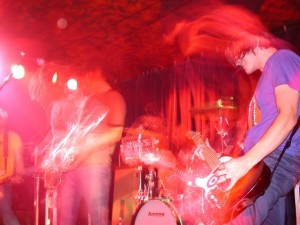
I first heard Shiner in 1997 via a mix tape containing “Fetch a Switch” and “The Situationist,” the best songs from their first two records, 1995’s Splay and the recently released Lula Divinia. I consulted Parasol Records’ catalog description to make sure my ears weren’t deceiving me—“Hum meets Jawbox,” yes, please—and promptly ordered Lula. Instantly a fan, I eagerly picked up their Sub Pop 7” for “Sleep It Off” b/w “Half Empty” and proudly wore a “SHINER” mock-Army t-shirt in high school. Absolutely none of my classmates understood it.
That changed when I left for college Champaign, IL, in 1999. The Midwest was Shiner’s literal stomping ground; they toured constantly and left ears ringing in their wake. Yet it’s still shocking to me that I’d get to see a non-local band eleven times in four years, even if it involved going to five other cities in the Midwest. Appropriately enough, only Allen Epley’s post-Shiner band The Life and Times matches that total.
That tie is about to be broken, however, since Shiner has reunited for five shows this summer in honor of an impending vinyl pressing of their 2001 swan song, The Egg. The concerts are slated for each member’s respective home city: New York, Chicago (x2), Kansas City, and Los Angeles, and you’re damn right I’m driving down to New York for my twelfth Shiner show.
In honor of this occasion, I’ve decided to do two things. First, if you haven’t heard Lula Divinia or The Egg, I’ll do you a favor and tell you to stop reading and buy them immediately. The combination of supreme heft, math-rock-inclined arrangements, and sneaky melodies is a gift that keeps giving. Second, I’m going to look back at each of the eleven previous times I saw Shiner. I’ll drag out photos, recall the accompanying acts (many of whom were legitimately great on their own accord), and do my best to remember the actual sets.
1/28/2000 at the Rocketbar in St. Louis, MO
I scored a ride from Champaign down to St. Louis because Centaur, Matt Talbott’s post-Hum band, was booked for its second-ever show there. I rolled with a lot of Hum fanatics at the time, and three of us had just seen Centaur play its first-ever show at a VFW in Danville, IL, a hangdog affair in which band members confused their then-numbered songs in front of some completely oblivious locals. This time, my friend Jackie and I were considerably more excited to see Shiner.
Autosleeper was first on the bill. The band name is presumably a reference to the Chapterhouse song title, but I remember thinking they were a pale imitation of both Shiner and Hum, not Midwestern-gaze.
Centaur’s sheepish emergence into the world continued. I have three distinct memories of their performance: Matt Talbott’s comically large beer bottle being at odds with their otherwise stoic stage presence; what would eventually become “The Same Place” comprising the best eight minutes of the set; and Talbott’s wah pedal breaking two songs in, to which he sighed “My band’s in this pedal.” Their performance sputtered out after one more song, proving Talbott’s assertion that his pedal truly was indispensible.
Shiner took the stage as a four-piece with Jason Gerken on drums and Josh Newton on second guitar, a new line-up for the group, not that I’d seen the others. Gerken had taken over for much-heralded Tim Dow, who’d moved to Los Angeles (where he’d collaborate with Failure’s Ken Andrews in both On and Year of the Rabbit). Newton replaced Joel Hamilton, who’d appeared on “Sailor’s Fate,” the solid b-side to their stellar 1999 single “Semper Fi.” True to Shiner form, both members had served time in Kansas City’s Season to Risk, but Gerken was more known for Molly McGuire, Newton better associated with Glazed Baby.
I was impressed by early versions of songs that would end up on Starless, especially “Unglued” and “Lazy Eye” (which sounded more eerie and threatening than it would on the album), but most of my memories from that night were of Gerken’s appearance and performance. He went shirtless with overalls—not a look I could pull off—and played with a swagger that he’d later tone down. I was borderline terrified of him.
9/28/2000 at the Metro in Chicago, IL
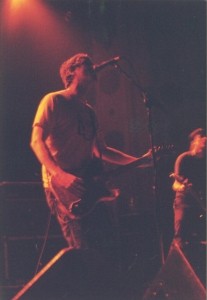
I celebrated the night before my 20th birthday with a trip up to Chicago for the dude-rockingest night of the Flower Booking Festival. In hindsight, I should have attended all of the nights: Trans Am, Don Caballero, Tortoise, The Sea & Cake, Grifters, Turing Machine, etc., but come on, Burning Airlines and Shiner? That’s the one I’m attending.
Bluetip started off the evening as no slouch of an opening act. I’d only heard the Hot (-) Fast (+) Union EP at the time, but I enjoyed it, especially “Compliment the Negative.” Did I immediately pick up the rest of their back catalog? Of course not. I regret this inaction. They were solid live and I never got to see them again.
Shiner was second on the bill, which meant they played a shorter set than I would have preferred. It was good hearing the Starless songs after the record came out—the title track was considerably better live. I recall “Fetch a Switch” making a welcome appearance.
The recently formed Hey Mercedes (75% of Braid) was third. I’d seen them in Champaign with Rectangle a few weeks earlier and learned a valuable lesson about the diminishing returns of early Hey Mercedes shows. The first song: “Whoa, this is great! It’s catchier than Braid!” Third song: “Still good! Still catchy!” Fifth song: Looks at watch. Seventh song: “How many more dunna-nuh, dunna-dunnas do they have in them?” In short, they didn’t have forty minutes of varied material yet and by the end of their set I was exhausted. I enjoyed their shows more once they had a full LP out, but as it turned out, “Bells” and “The House Shook” from that first EP remain my two favorite Hey Mercedes songs.
I’d seen Burning Airlines the previous October at the Highdive in Champaign, but this time they had a bunch of new material that was being road-tested before appearing on Identikit. Hearing “A Song With No Words” for the first time that evening was phenomenal. I wish I could watch J. Robbins play guitar every night, but sadly, he has other things to do.
I am fairly sure The Promise Ring were the evening’s special guest, but sticking around for another band after Burning Airlines felt sacrilegious to me. I did see The Promise Ring three other times in college, two of which were enjoyable sets highlighted by Davey Von Bohlen’s deft handling of hecklers, the last a baffling pre-Wood/Water set that trading their pop-punk enthusiasm for alt-country slogs.
1/20/2001 at the Highdive, Champaign, IL
Perhaps owing to the fact that I didn’t have to drive to a different city to attend the show, I can’t remember many of the details about this show. Centaur had certainly improved—their songs likely had names, not numbers by this point—and drummer Jim Kelly and bassist Derek Niedringhaus were holding down the fort. It was still a year before In Streams would come out. Will it ever get a follow-up? Who knows. They played unreleased songs at later shows, but even those concerts were way back in 2004 and 2005.
As for Shiner, I wish I had the set list for this show, since I’m curious whether they’d started to play songs from The Egg yet. My gut says no, but there are YouTube clips from a show at the Bottleneck in Kansas City from 2/3/2001 for “Surgery,” “The Simple Truth,” “Spook the Herd” (vastly different lyrics), “Bells and Whistles,” and “The Truth about Cows.” My guess is that they chose to debut the new material at the hometown show.
5/11/2001 at the Galaxy in St. Louis, MO
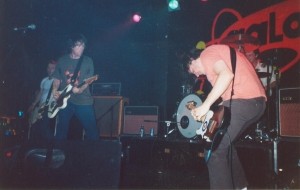
With the finals of my sophomore year of college in the rearview, my then-girlfriend, now-wife (henceforth TGNW) and I drove down to St. Louis to hang out with my friend Jon Mount and see Shiner for the fourth time. Given the fact that Riddle of Steel’s bassist ran the Rocketbar, I was surprised that the show wasn’t over there.
Both opening acts were bands that my peers generally appreciated more than I did. Riddle of Steel combined Midwestern indie rock with a larger dose of hard rock. If I lived in St. Louis, I likely would have seen them countless times, but they didn’t play Champaign much.
Houston had the Copper Press (the print magazine I occasionally contributed to, including a piece on Shiner) stamp of approval, since editor Steve Brydges snapped them up for his label, 54 40 or Fight, but I couldn’t get into them for one simple reason: their live guitar tone. It evoked a thinner, more metallic version of the guitar tones of Failure’s Comfort, which was like nails on a chalkboard for me. That’s a damn shame, since I otherwise liked their songwriting. (The cover art for Bottom of the Curve is inexcusably terrible, though.) I saw Houston three other times: their best performance came on a bill with Ring, Cicada at the Prairie House in Bloomington, IL.
One between-song comment to Jon Mount stands out about this show. After Shiner played “The Situationist” near the end of their set, I said “They definitely know which songs are their best,” to which he agreed. I’ve seen bands that play everything but the three or four best songs in their catalog, which is infuriating, but Allen Epley’s bands have never suffered from that issue.
8/11/2001 at the Southgate House in Newport, KY
If I had to rank my favorite all-time shows—a simple dare would get this project started—this one would be up there. I got to leave early from a family get-together for my TGNW’s family, which alone was cause for celebration, and cross from Cincinnati over to Newport, Kentucky for the show. The Southgate House was a great venue, like someone stuck a less claustrophobic version of the Middle East Downstairs into the back of a huge house. And the bill was, for my tastes, comparable to the Flower Booking night.
I was introduced to Spain’s Aina from a split 7” with The Capitol City Dusters in 1999. Aina’s contribution, “Lutton Can Wait,” is one of my most-played sides of vinyl, to the point where I had to buy a second copy of the record. Their sound is as easy to describe as it is to appreciate: the DC rock of Jawbox and Fugazi cut with the hard rock of AC/DC. Even with my fondness for “Lutton Can Wait,” I didn’t expect them to be this good. When a massive thunderstorm opened up outside midway through their set, singer/guitarist Artur Estrada pointed up at the lightning strikes and the band hit another gear. If you missed out on them, put their 1998 self-titled LP and 2001’s Bipartite on your to-buy list and check out Artur Estrada’s next band, Nueva Vulcano.
This is what I remember about Shiner’s set: “Holy shit, ‘The Egg’ and ‘The Simple Truth’ are insanely good.” The former might be Jason Gerken’s answer to Tim Dow’s work on “My Life as a Housewife,” whereas the latter pulled in some post-rock influence to excellent effect.
I could have gone home ecstatic after Aina and Shiner, but Burning Airlines was the icing on the cake. They played a solid, Identikit-heavy set. I remember talking to drummer Pete Moffett at the show, but damned if I recall what we chatted about. I got to see them one final time in Champaign the next month on another solid bill (Rival Schools and Hey Mercedes), but J. Robbins’ days of heavy touring were soon coming to a close. Am I still bummed Jawbox didn’t do any proper reunion shows for the For Your Own Special Sweetheart reissue? Yes, yes I am.
10/19/2001 at the Metro in Chicago, IL
In one of the weirder bills in my concert-going history, Shiner took the middle slot between two Barsuk bands, piano rockers The Prom and the rapidly ascending Death Cab for Cutie. In one sense, Shiner and Death Cab sharing a bill makes sense, since Death Cab toured with Shiner’s DeSoto Records label-mates The Dismemberment Plan and briefly shared bassist Nick Harmer with another beloved DeSoto band, Juno. But despite the mutual fondness for both bands between my TGNW and me, bridging the gap between air-drumming dude-rockers and a sensitive emo kids was a tall order.
There was no doubt which side of that ledger The Prom fell on. Imagine Ben Folds Five’s “Brick” as an early 2000s emo song and you’re 85% of the way there. Fortunately, my now-wife didn’t care for them, so I avoided having to buy that CD and hear it a few times. Phew.
My desire to hear songs from Shiner’s forthcoming The Egg again was bordering on a bodily need. It’s different now that you can see videos of unreleased songs on YouTube before they’re recorded, but in 2001, the only way I could wrap my head around “The Simple Truth” and “The Egg” was to see Shiner perform them as much as possible. It was a rare situation even then—most bands don’t tour heavily before their new album comes out, but Shiner was an exception to that rule. I’m endlessly thankful that they were.
The album was three days away from its release, but by this point “The Simple Truth” and “The Egg” were the standouts of their set. I reveled in the fact a number of Death Cab fans around me were plugging their fingers into their ears and grimacing.
I remember talking to Josh Newton at this show and asking him how their dates with Death Cab were going. He relayed a story from one of the previous nights, in which he was in the back of the club playing Golden Tee during their set, and the song approached silence. Naturally, Golden Tee made a ton of noise and a good percentage of the audience turned around and glared at him.
The members of Death Cab for Cutie, however, had a better sense of humor. Their amps had DC/FC stylized in the AC/DC font, so naturally I yelled out for AC/DC songs. They laughed, but sadly didn’t break out a rendition of “Big Balls.” I couldn’t help but feel the letdown after Shiner, however, since Death Cab’s set was quieter than the one they’d played at the sweaty Fireside Bowl nine months earlier (before The Photo Album increased their hype considerably) and couldn’t help but feel like an elongated, post-coital cuddle session.
One more note: we also managed to see Rectangle and Danger Adventure at The Big Horse, a Mexican restaurant/music venue. It was the only time I saw Rectangle outside of Urbana-Champaign, but the sound was so terrible that I probably only heard half of them.
10/20/2001 at the Highdive in Champaign, IL
There aren’t many bands I’ve seen on back-to-back nights, but Shiner joined the club when they headed down to Champaign to play The Egg in its entirety. That gimmick isn’t necessarily my favorite—I like guessing which song’s coming up next—but it worked for Shiner, since The Egg is an album in the way some decrepit Rolling Stone critic might someday elucidate. Plus they weren’t doing it as a way to milk dutiful fans out of another $40 (cough, Pixies, cough).
Not that I needed more reason to attend, but finally getting to see Collinsville, Illinois, instrumental rockers, Ring, Cicada as the lone openers for this show, but waiting is appropriate for the band. Having existed in some form or another since the mid ’90s, Ring, Cicada didn’t release a proper LP until 2003’s Good Morning, Mr. Good, which was sadly overlooked. They had a few short run EPs before the LP, but nothing that extended past regional affection. Naturally, all of my friends who had seen then raved about their performances, and rightly so: Ring, Cicada played an unusually emotional brand of math-rock. I remember being floored by their guitar tones, which were the direct opposite of Houston’s Achilles heel. I could throw a bunch of tired adjectives at you—warm, full-bodied, rich—but they wouldn’t tell the whole story. Guitarist Christian Powell emerged as an occasional vocalist on Good Morning, but the instrumental takes were hardly deficient.
Two key Shiner connections: first, bassist Eric Abert has been in The Life and Times since 2005, second, Ring, Cicada is on the bill for the Shiner reunion show at the Bottom Lounge, which makes me sad I’m no longer within driving range of Chicago.
4/6/2002 at the Highdive in Champaign, IL
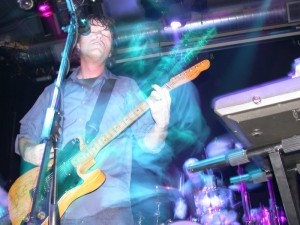
I’d come back from a road trip to Louisville, Kentucky the day before, glowing from a dominating triple bill of Fugazi, Shipping News, and Rachel’s (RIP Jason Noble), and was thrilled to see Shiner as well. While the Flower Booking and Southgate House bills were better, this evening might rank as my favorite Shiner performance.
The only opener was Schatzi, who bridged the gap between indie rock, emo, and pop-punk. Super enthusiastic and melodically driven, like a cross between Superchunk and The Get-Up Kids. I thought of them last year when I heard Hammer No More the Fingers’ Black Shark; it’s similarly catchy, but HMNTF's songs stuck with me, whereas I forgot about Schatzi’s songs by the end of the night.
Feel free to blame Shiner’s set for my Schatzi amnesia. They played both of the Japanese bonus tracks from The Egg, “Dirty Jazz” and “I’ll Leave Without You,” which were great live. They continued to play the best songs from The Egg, along with the highlights from earlier records. Perhaps the most obvious reason for me to think of this show more than the others is that I have a 24x18” blow-up of the accompanying photo above my desk.
I took it with my new Nikon digital camera, which I was still learning how to use. Results were mixed, but since Shiner didn’t shy away from lights, I could do my flash-and-long-exposure technique to get either motion or ghost images. That particular photo is the best ghost image I’ve ever taken—Epley looks like he’s conjuring a raging spirit. If I had steadier hands, maybe Gerken’s kit wouldn’t look like a neon smear.
7/3/2002 at Radio Radio in Indianapolis, IN
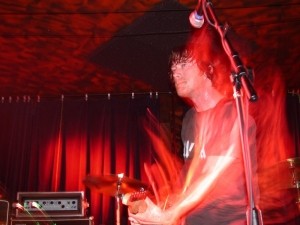
I’ve mentioned my TGNW a few times, but I have to give her credit: When I’d have the crazy idea to drive out to Indianapolis to see Shiner the night before the Fourth of July, she gladly tagged along. And this show was in the pre-Yelp days, so I literally knew nothing else to do in Indianapolis. If it wasn’t on the block of the club, I didn’t know about it. I guarantee we ate dinner at some shitty pizza joint. That was the golden age for shitty pizza joints.
New York City’s Pilot to Gunner was the first act on the bill. I’d heard their Hit the Ground and Hum EP when it came out, since its press release named the right names (Jawbox, Mission of Burma), but wasn’t impressed. The day of the show I decided to check out their new full length, Games at High Speed, on eMusic, and was stunned by how much they’d improved. Their high-energy post-punk shout-alongs were even better live. I chatted with them after their set and learned they’d just played the Prairie House in Bloomington, IL, and one of them sheepishly admitted to making out with Nudie, a frequent visitor to the Prairie House. Nudie, as you might imagine, had a tendency to get naked (along with one of house’s residents) in the routine after-show dance parties. More importantly, Nudie had a tattoo on her inner thigh: an arrow pointing crotchward with “Tasty” written nearby. Regardless of their beer goggles, I still enjoy Pilot to Gunner a great deal, and am glad they’re finally following up 2004’s Get Saved with the upcoming Guilty Guilty on Arctic Rodeo Records (the same label that’s issuing Burning Airlines’ two albums on vinyl).
Shiner’s set was looser than the past few—they weren’t promoting The Egg as hard and they were in the middle slot on the bill, so they skipped around their albums a bit more. As much as I loved hearing songs from The Egg the previous summer, it was nice to get more from Lula again.
Jets to Brazil closed out the show. Is it slander to admit that I was never obsessed with Jawbreaker or Jets to Brazil? Probably just lost a bunch of cred points. I do enjoy Orange Rhyming Dictionary, especially “Chinatown” (along with a few Jawbreaker albums), but when it came down to Jawbox/Burning Airlines vs. Jawbreaker/Jets to Brazil in the non-existent battle of the similarly named bands, I’m a J. Robbins guy all the way.
11/11/2002 at The Highdive in Champaign, IL

I doubt that I saw any of The Capitol City Dusters’ set and here’s why: I had a long interview with Aina drummer Pau Santesmasses, who had the best command of English in the group, and planned to work it into a piece for Copper Press. But I assume that my finals kept me from working on it, and the interview—which I remember being quite insightful to their fondness for DC music—sat on a microcassette, untouched. It’s probably still in a bin in my basement. I feel genuinely shitty about it.
Aina, of course, were excellent, just like they’d been the year before. By this point I’d been able to process their records, so the shock and awe of the Southgate House performance had worn off, but their command of the material hadn't. I gladly would have seen them another nine times, but they broke up after a pair of EPs.
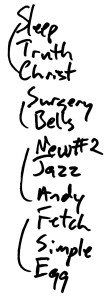
I only have one Shiner set list in my possession and it’s from this show. Do I remember what “New #2” was? Sadly not. Otherwise, the song selection is flawless. “Sleep It Off” from the Sub Pop single has always been one of my favorites, and I don’t recall them playing it too often.
One note: I believe this was the show when Paul Malinowski said something like “I see you at a lot of these shows” to me. Yes, yes you did.
1/25/2003 at the Madrid Theater in Kansas City, MO
When Shiner announced in late 2002 that they were breaking up, I wasn’t hugely surprised. That may be strange for an obsessive fan to admit, but what drove Shiner was Allen Epley’s desire to improve the band. That’s what he did with the three-piece version on Lula Divinia vs. Splay, that’s what he did with the four-piece version on The Egg vs. Starless. In some ways, Shiner wrote themselves into a corner with The Egg; there was no inferior band member to replace, no obvious flaw to correct. The clearest course was to do something different, which was easier to do with a new band name and new collaborators. Epley’s too committed to music to quit entirely, so I knew he wasn’t going to disappear into a day job, and sure enough, he emerged a shortly after with The Life and Times.
That isn’t to say that I wasn’t disappointed that Shiner was breaking up, since I wouldn’t get to see those songs live again (for a decade, at least). As such, there was no way in hell I’d miss out on their final show. It’s the longest I’ve driven for a concert—although I admittedly flew from Boston to Seattle for Juno’s reunion shows—and I’m eternally grateful that Jackie, Jon, and Bill joined me for the adventure. It’s entirely possible I might have died on the drive back to St. Louis if not for the gentle nudge that I should stop and walk around.
I remember very little about opening act Elevator Division—they were the local opener without the local sound, and given the number of Kansas City bands I’ve enjoyed over the years, that felt like an intrusion on a proper send-off. In comparison, Shiner’s common touring partner Houston was a good fit, irritating guitar tone be damned.
The last opening act was considerably more exciting. Dirtnap was/is a Kansas City band who’d released two excellent records (the still-weird combination of atmospheric Slint post-rock and aggressive Midwestern rock of 1997’s Below the Speed of Sound and the emotional resonance and superlative guitar work of 2003’s Long Songs for Short Term Friends), but hadn’t ventured out to Champaign during my time there. They apparently played a show in Kansas City back in April, which fortunately made it up to YouTube. Excuse me while I watch all of it.
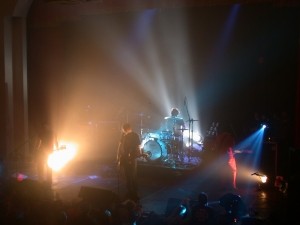
Shiner’s final performance was a blowout in the best possible way. They played 24 songs in a nearly two-hour-long set. Thax Douglas, poet laureate of rock shows in Chicago, came out to do a reading. They played songs I hadn’t heard them do in ages (“Released,” “Sideways”/“Pinned”). The encore started with the Splay lineup of Epley, Dow, and bassist Shawn Sherrill performing “Brooks,” then swapped Sherrill for Malinowski to do Lula material, including Dow’s drumming clinic “My Life as a Housewife.” (Fun fact: Gerken wouldn’t do “Housewife” because Dow owned it so much.) Watching Dow drum was a thrill—he’s a much smaller guy than Gerken, but still hits with such power and precision. Newton and Gerken reemerged for the last few songs, closing the night with “Starless.” It was an appropriately somber closing note, reminding everybody that yes, they’re done.
(Until the reunion shows, of course.)
You can download their final set here. Thanks to whoever originally recorded and dispersed it. I believe Shiner is still planning on releasing a retrospective DVD, which may contain some or all of this set.
|
|

